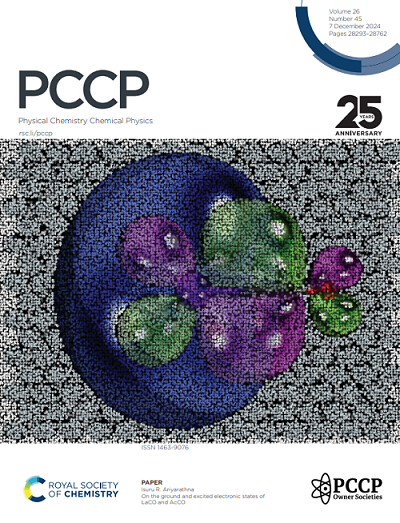Integrating Density Functional Theory with Machine Learning for Enhanced Band Gap Prediction in Metal Oxides
IF 2.9
3区 化学
Q3 CHEMISTRY, PHYSICAL
引用次数: 0
Abstract
In this study, we used a combination of density functional theory with Hubbard U correction (DFT+U) and machine learning (ML) to accurately predict the band gaps and lattice parameters of metal oxides: TiO2 (rutile and anatase), cubic ZnO, cubic ZnO2, cubic CeO2, and cubic ZrO2. Our results show that including Up values for oxygen 2p orbitals alongside Ud/f for metal 3d or 4f orbitals significantly improves the band gap and lattice parameters predictions. Through extensive DFT+U calculations, we identified optimal (Up, Ud/f) integer pairs that closely matched the experimental values for band gaps and lattice parameters: (8 eV, 8 eV) for rutile TiO2, (3 eV, 6 eV) for anatase TiO2, (6 eV, 12 eV) for c-ZnO, (10 eV, 10 eV) for c-ZnO2, (9 eV, 5 eV) for c-ZrO2 and (7 eV, 12 eV) for c-CeO2. Our ML analysis demonstrated that simple supervised ML models can reliably achieve accuracy comparable to DFT+U calculations. These models have the potential to extend beyond the metal oxides used in training and to explore the effects and dependencies of U values on the bulk properties of materials. Our study not only identifies the best U pairs for predicting experimentally measured band gaps and lattice parameters but also highlights the effectiveness of straightforward regression ML models in predicting the band gaps and lattice parameters of metal oxides.在这项研究中,我们将密度泛函理论与哈伯德U校正(DFT+U)和机器学习(ML)相结合,准确预测了金属氧化物的带隙和晶格参数:TiO2(金红石型和锐钛型)、立方氧化锌、立方氧化锌、立方氧化 CeO2 和立方氧化锆。我们的研究结果表明,将氧 2p 轨道的 Up 值与金属 3d 或 4f 轨道的 Ud/f 值结合起来,能显著改善带隙和晶格参数的预测。通过大量的 DFT+U 计算,我们确定了最佳(Up、Ud/f)整数对,它们与带隙和晶格参数的实验值非常吻合:(金红石型二氧化钛为(8 eV,8 eV),锐钛型二氧化钛为(3 eV,6 eV),c-ZnO 为(6 eV,12 eV),c-ZnO2 为(10 eV,10 eV),c-ZrO2 为(9 eV,5 eV),c-CeO2 为(7 eV,12 eV)。我们的 ML 分析表明,简单的监督 ML 模型可以可靠地达到与 DFT+U 计算相当的精度。这些模型有潜力扩展到训练中使用的金属氧化物之外,并探索 U 值对材料体特性的影响和依赖性。我们的研究不仅确定了预测实验测量的带隙和晶格参数的最佳 U 对,还强调了直接回归 ML 模型在预测金属氧化物带隙和晶格参数方面的有效性。
本文章由计算机程序翻译,如有差异,请以英文原文为准。
求助全文
约1分钟内获得全文
求助全文
来源期刊

Physical Chemistry Chemical Physics
化学-物理:原子、分子和化学物理
CiteScore
5.50
自引率
9.10%
发文量
2675
审稿时长
2.0 months
期刊介绍:
Physical Chemistry Chemical Physics (PCCP) is an international journal co-owned by 19 physical chemistry and physics societies from around the world. This journal publishes original, cutting-edge research in physical chemistry, chemical physics and biophysical chemistry. To be suitable for publication in PCCP, articles must include significant innovation and/or insight into physical chemistry; this is the most important criterion that reviewers and Editors will judge against when evaluating submissions.
The journal has a broad scope and welcomes contributions spanning experiment, theory, computation and data science. Topical coverage includes spectroscopy, dynamics, kinetics, statistical mechanics, thermodynamics, electrochemistry, catalysis, surface science, quantum mechanics, quantum computing and machine learning. Interdisciplinary research areas such as polymers and soft matter, materials, nanoscience, energy, surfaces/interfaces, and biophysical chemistry are welcomed if they demonstrate significant innovation and/or insight into physical chemistry. Joined experimental/theoretical studies are particularly appreciated when complementary and based on up-to-date approaches.
 求助内容:
求助内容: 应助结果提醒方式:
应助结果提醒方式:


